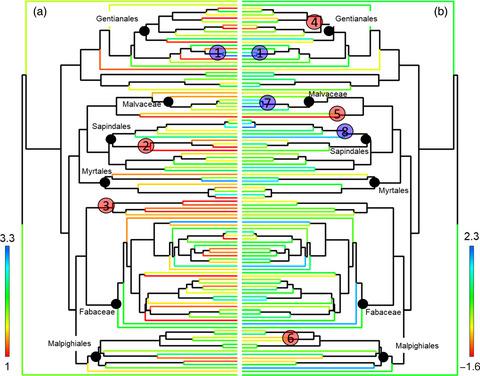Our official English website, www.x-mol.net, welcomes your
feedback! (Note: you will need to create a separate account there.)
Evolutionary constraints on tree size and above‐ground biomass in tropical dry forests
Journal of Ecology ( IF 5.3 ) Pub Date : 2021-01-10 , DOI: 10.1111/1365-2745.13589 Natalia de Aguiar‐Campos 1 , Fernanda Coelho de Souza 2 , Vinícius Andrade Maia 1 , Vanessa Leite Rezende 3 , Cleber Rodrigo de Souza 1 , Gabriela Gomes Pires de Paula 1 , Paola Ferreira Santos 3 , Gisele Cristina de Oliveira Menino 4 , Wilder Bento da Silva 1 , Rubens Manoel dos Santos 1
中文翻译:

热带干旱森林中树木大小和地上生物量的进化限制
更新日期:2021-01-10
Journal of Ecology ( IF 5.3 ) Pub Date : 2021-01-10 , DOI: 10.1111/1365-2745.13589 Natalia de Aguiar‐Campos 1 , Fernanda Coelho de Souza 2 , Vinícius Andrade Maia 1 , Vanessa Leite Rezende 3 , Cleber Rodrigo de Souza 1 , Gabriela Gomes Pires de Paula 1 , Paola Ferreira Santos 3 , Gisele Cristina de Oliveira Menino 4 , Wilder Bento da Silva 1 , Rubens Manoel dos Santos 1
Affiliation

|
- The extent (or lack) of phylogenetic signal for key ecological traits reveals the role of evolutionary processes on present‐day ecosystem function and hints on future ecological trends under climate change scenarios. This approach has been applied to South American tropical moist forests, but not to the highly threatened seasonally dry tropical forests (SDTF), despite the acknowledgement of their unique evolutionary history. To fill this knowledge gap, we investigated the legacy of evolutionary processes on vital ecological characteristics among SDTF trees: regional dominance, tree size and soil preference.
- We used tree community data on 313 plots of SDTF (12.52 ha) and locally collected soil data in central‐eastern Brazil. For each assessed trait (three for regional dominance, three for tree size and nine for soil preference), we investigated the legacy of evolution using two different approaches: calculating the extent of phylogenetic signal and comparing the fit of four different models of evolution.
- Above‐ground woody biomass and tree size showed strong phylogenetic signal. Most of the SDTF biomass stock was concentrated on a few large‐sized and closely related tree genera. Among the soil preference variables, only phosphorus displayed significant, albeit weak, phylogenetic signal.
- Synthesis. Our study is the first to show that evolutionary constraints related to tree size significantly determine regional biomass stocks of seasonally dry tropical forests (SDTF) in a few closely related tree lineages. This suggests that even isolated SDTF fragments with low taxonomic and phylogenetic diversity can play an important role in the global carbon cycle, storing disproportionally large amounts of carbon in trees that belong to high‐biomass lineages. Whether these lineages also share climate change‐induced mortality risk deserves future investigation, as they are largely responsible for the maintenance of regional SDTF biomass stocks.
中文翻译:

热带干旱森林中树木大小和地上生物量的进化限制
- 重要生态特征的系统发育信号的程度(或缺乏)揭示了进化过程对当今生态系统功能的作用,并暗示了气候变化情景下未来的生态趋势。尽管承认了其独特的进化历史,但该方法已应用于南美热带湿润森林,但未应用于受到高度威胁的季节性干旱热带森林(SDTF)。为了填补这一知识空白,我们研究了SDTF树木在关键生态特征方面的进化过程遗留问题:区域优势,树木大小和土壤偏好。
- 我们使用了313个SDTF(12.52公顷)样地上的树木群落数据和巴西中东部的本地收集的土壤数据。对于每个评估的特征(三个用于区域优势,三个用于树大小,九个用于土壤偏好),我们使用两种不同的方法研究了进化的遗产:计算系统发生信号的程度以及比较四种不同的进化模型的拟合度。
- 地上木质生物量和树木大小显示出强烈的系统发生信号。SDTF的大多数生物量资源都集中在一些大型且密切相关的树属上。在土壤偏好变量中,只有磷显示出显着的,即使是较弱的系统发生信号。
- 综合。我们的研究首次表明,与树木大小相关的进化约束条件显着决定了一些密切相关的树木世系中季节性干燥热带森林(SDTF)的区域生物量储量。这表明,即使是具有低分类学和系统发育多样性的分离的SDTF片段也可以在全球碳循环中发挥重要作用,在属于高生物量谱系的树木中不成比例地存储大量碳。这些谱系是否也具有气候变化引起的死亡风险,值得我们进一步研究,因为它们主要负责维护SDTF区域的生物量。











































 京公网安备 11010802027423号
京公网安备 11010802027423号